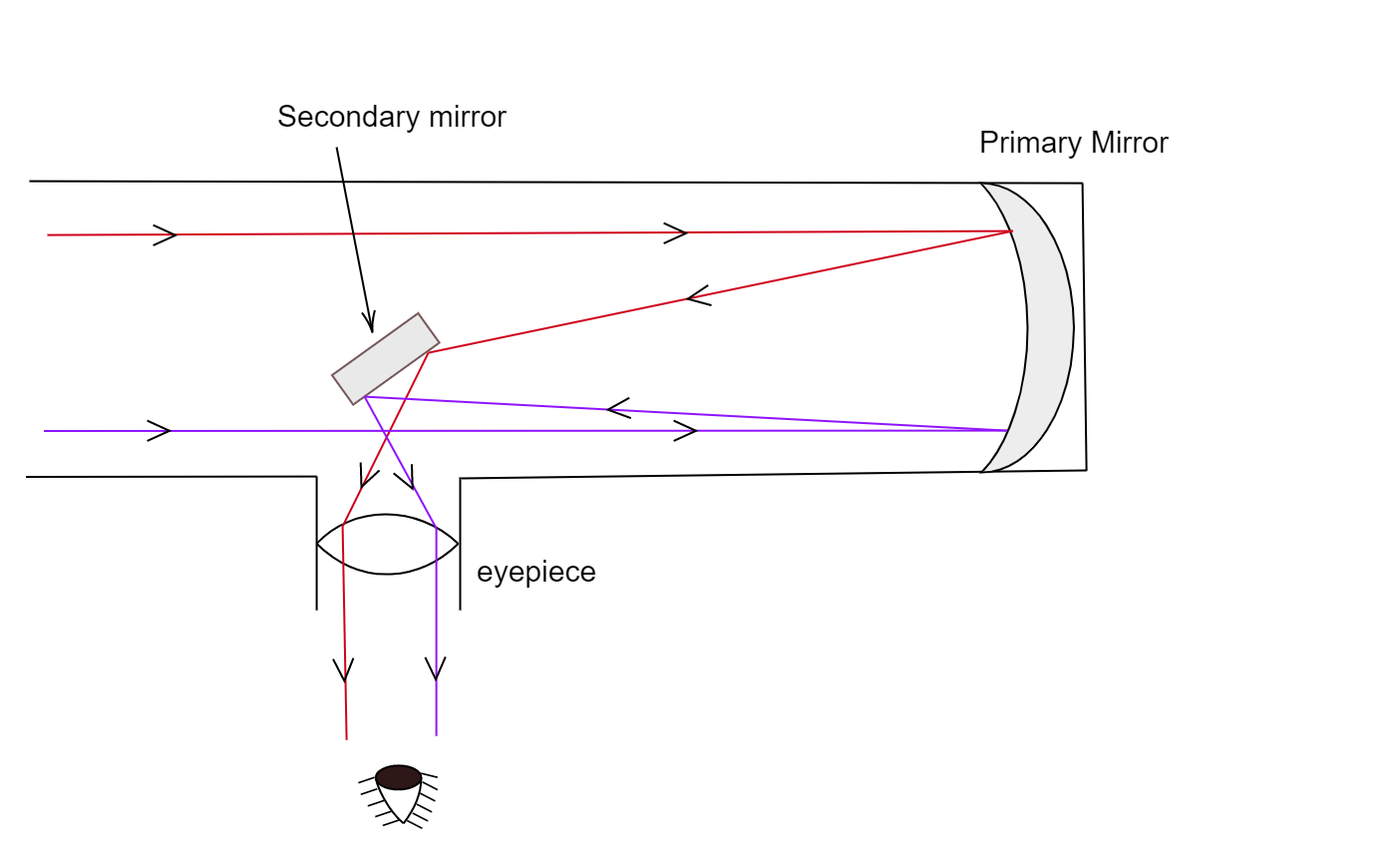
Draw ray diagram of reflecting telescope for image formation. How can we increase its resolving power?
Answer
516k+ views
Hint: A reflecting telescope uses two mirrors to form the image of a distant object, the use of a mirror instead of an optical lens reduces the chromatic aberration caused by it. The resolving power of the telescope depends on the diameter of the objective.
Complete answer:
The first reflecting telescope was developed by Newton in the 17th century. Before this optical lenses were used to form images from different optical devices. But there is a similarity in the behaviour of spherical mirrors and optical lenses. This property of mirrors was used by Newton to construct the Reflecting Telescope.
A telescope is used to provide angular magnification, which helps to observe distant objects with ease. It has an objective and eyepiece. The objective is made large in order to collect as much light as possible. So in a telescope, to increase the resolving power, a large diameter of the objective is required.
In a reflecting telescope, the objective is a large concave mirror, which collects light from the distant and faint sources, and focuses it on its focus as the rays entering the telescope are parallel. Using a parabolic reflecting surface also removes the spherical aberration. The image is focussed inside the tube of the telescope. So to reach the eyepiece, it is diverted using a convex or plane mirror. Then the image is magnified in the eyepiece.
The following is the ray diagram of a reflecting telescope-

Note:
Small lenses do not show many aberrations because they are thin. But when large lenses are used the light has to be refracted for a much larger distance which creates some dispersion, and is also reduced in intensity due to frequent absorption and emission. Similarly, at bigger scales spherical mirrors do not form images into their focus, to overcome these parabolic mirrors are used in reflecting telescopes.
Complete answer:
The first reflecting telescope was developed by Newton in the 17th century. Before this optical lenses were used to form images from different optical devices. But there is a similarity in the behaviour of spherical mirrors and optical lenses. This property of mirrors was used by Newton to construct the Reflecting Telescope.
A telescope is used to provide angular magnification, which helps to observe distant objects with ease. It has an objective and eyepiece. The objective is made large in order to collect as much light as possible. So in a telescope, to increase the resolving power, a large diameter of the objective is required.
In a reflecting telescope, the objective is a large concave mirror, which collects light from the distant and faint sources, and focuses it on its focus as the rays entering the telescope are parallel. Using a parabolic reflecting surface also removes the spherical aberration. The image is focussed inside the tube of the telescope. So to reach the eyepiece, it is diverted using a convex or plane mirror. Then the image is magnified in the eyepiece.
The following is the ray diagram of a reflecting telescope-

Note:
Small lenses do not show many aberrations because they are thin. But when large lenses are used the light has to be refracted for a much larger distance which creates some dispersion, and is also reduced in intensity due to frequent absorption and emission. Similarly, at bigger scales spherical mirrors do not form images into their focus, to overcome these parabolic mirrors are used in reflecting telescopes.
Recently Updated Pages
Transformation Matrix Explained: 4x4 Types & Uses (2025 Guide)

Unit Matrix Explained: Definition, 3x3 & 2x2 Examples for 2025

Sum of Cubes Formula: Find the Sum of Cubes of n Natural Numbers

Surjective Function Explained for Students (2025)

Multiplying and Dividing Exponents: Rules & Step-by-Step Guide (2025)

Factored Form Explained: How to Convert & Examples for 2025

Trending doubts
Draw a diagram of nephron and explain its structur class 11 biology CBSE

The process in which gas transform into solid is called class 11 chemistry CBSE

Distinguish between Mitosis and Meiosis class 11 biology CBSE

How many quintals are there in one metric ton A 10 class 11 physics CBSE

State which of the following situations are possible class 11 physics CBSE

Identify the olfactory element in the following vanilla class 11 chemistry CBSE




